window OLDSMOBILE SILHOUETTE 1997 Owners Manual
[x] Cancel search | Manufacturer: OLDSMOBILE, Model Year: 1997, Model line: SILHOUETTE, Model: OLDSMOBILE SILHOUETTE 1997Pages: 436, PDF Size: 21.87 MB
Page 7 of 436
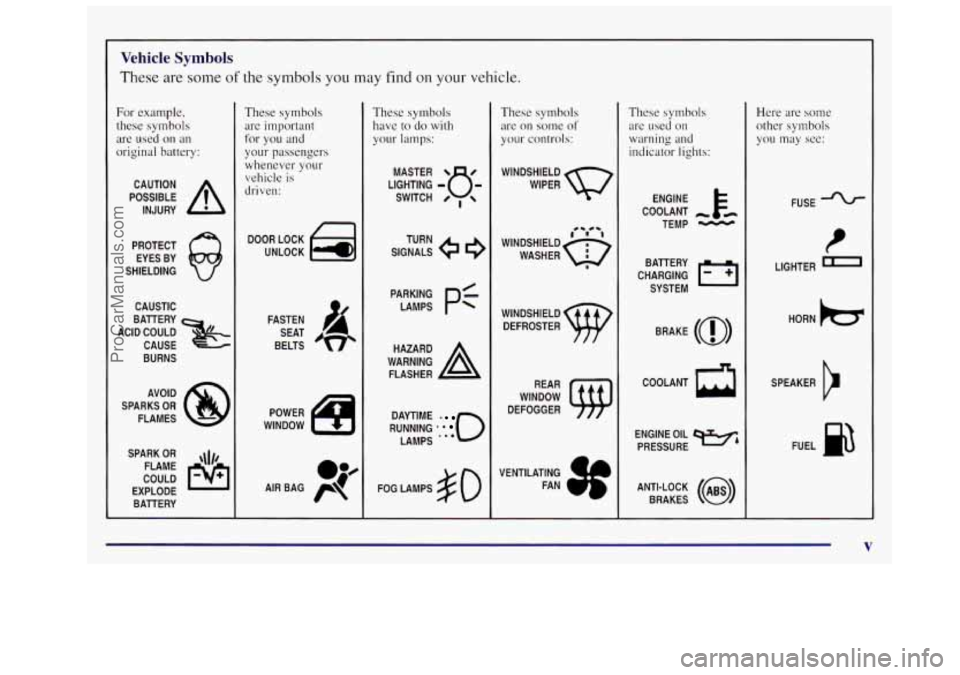
Vehicle Symbols
These are some of the symbols you may find on your vehicle.
For example,
these symbols
are used
on an
original battery:
POSSIBLE A
CAUTION
INJURY
PROTECT EYES BY
SHIELDING
CAUSTIC
ACID COULD
&
BATTERY
CAUSE
BURNS
AVOID
SPARKS
OR
FLAMES
SPARK
OR ,\I/,
COULD FLAME
EXPLODE BATTERY
These symbols are important
for you and
your passengers whenever your
vehicle is
driven:
DOOR LOCK
UNLOCK
FASTEN SEAT
BELTS
These symbols have
to do with
your lamps:
SIGNALS e
TURN
RUNNING
* ' 0
DAYTIME .
LAMPS .**
FOG LAMPS $0
These symbols
are
on some of
your controls:
WINDSHIELD
WIPER
WINDSHIELD DEFROSTER
WINDOW
DEFOGGER
VENTILATING FAN
These symbols are used
on
warning and
indicator lights:
COOLANT -
TEMP -
CHARGING 1'1
BATTERY
SYSTEM
BRAKE
(a)
COOLANT a
ENGINE OIL
PRESSURE
Wb
ANTI-LOCK (@)
BRAKES
Here are some
other symbols
you may see:
FUSE
P
LIGHTER -
HORN )tr
SPEAKER
b
FUEL B
ProCarManuals.com
Page 55 of 436
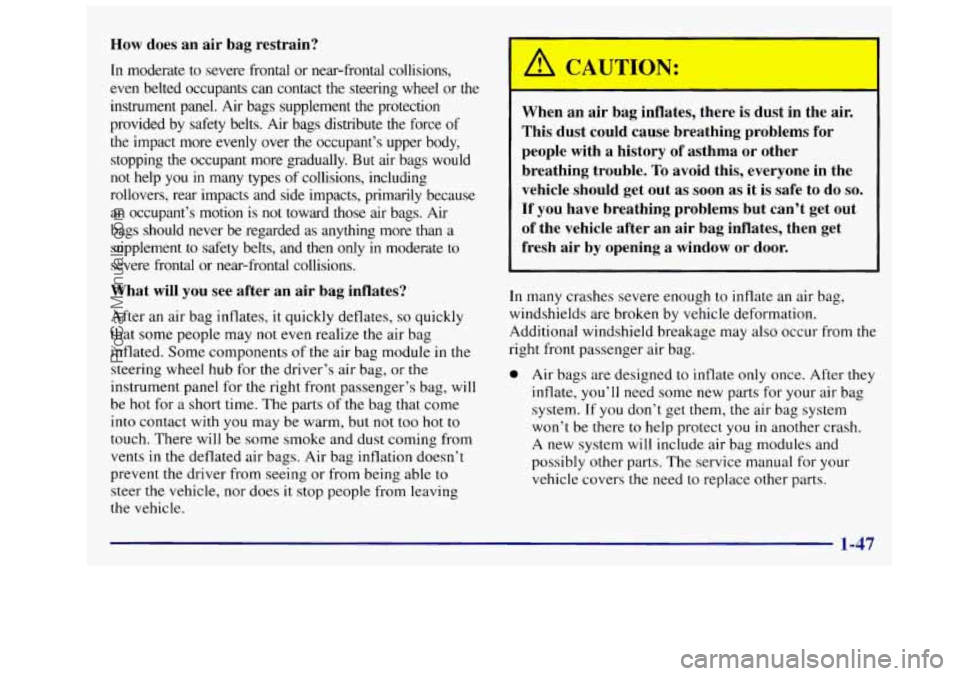
How does an air bag restrain?
In moderate to severe frontal or near-frontal collisions,
even belted occupants can contact the steering wheel or the
instrument panel. Air bags supplement the protection
provided by safety belts. Air bags distribute the force
of
the impact more evenly over the occupant’s upper body,
stopping the occupant more gradually. But air bags would
not help you in many types of collisions, including
rollovers, rear impacts and side impacts, primarily because
an occupant’s motion is not toward those air bags. Air
bags should never be regarded as anything more than a
supplement to safety belts, and then only in moderate to
severe frontal or near-frontal collisions.
What will you see after an air bag inflates?
After an air bag inflates, it quickly deflates, so quickly
that some people may not even realize the air bag
inflated. Some components of the air bag module in the
steering wheel hub for the driver’s air bag, or
the
instrument panel for the right front passenger’s bag, will
be hot for a short time. The parts of the bag that come
into contact with you may be warm, but not too hot
to
touch. There will be some smoke and dust coming from
vents in the deflated air bags. Air bag inflation doesn’t
prevent the driver from seeing or from being able to
steer the vehicle, nor does
it stop people from leaving
the vehicle.
When an air bag inflates, there is dust in the air.
This dust could cause breathing problems for
people with a history
of asthma or other
breathing trouble.
To avoid this, everyone in the
vehicle should get out as soon
as it is safe to do so.
If you have breathing problems but can’t get out
of the vehicle after an air bag inflates, then get
fresh air by opening a window or door.
In many crashes severe enough to inflate an air bag,
windshields are broken by vehicle deformation.
Additional windshield breakage may also occur from the
right front passenger air bag.
0 Air bags are designed to inflate only once. After they
inflate, you’ll need some new parts for your air bag
system.
If you don’t get them, the air bag system
won’t be there to help protect
you in another crash.
A new system will include air bag modules and
possibly other parts. The service manual for your
vehicle covers the need to replace other parts.
1-47
ProCarManuals.com
Page 58 of 436
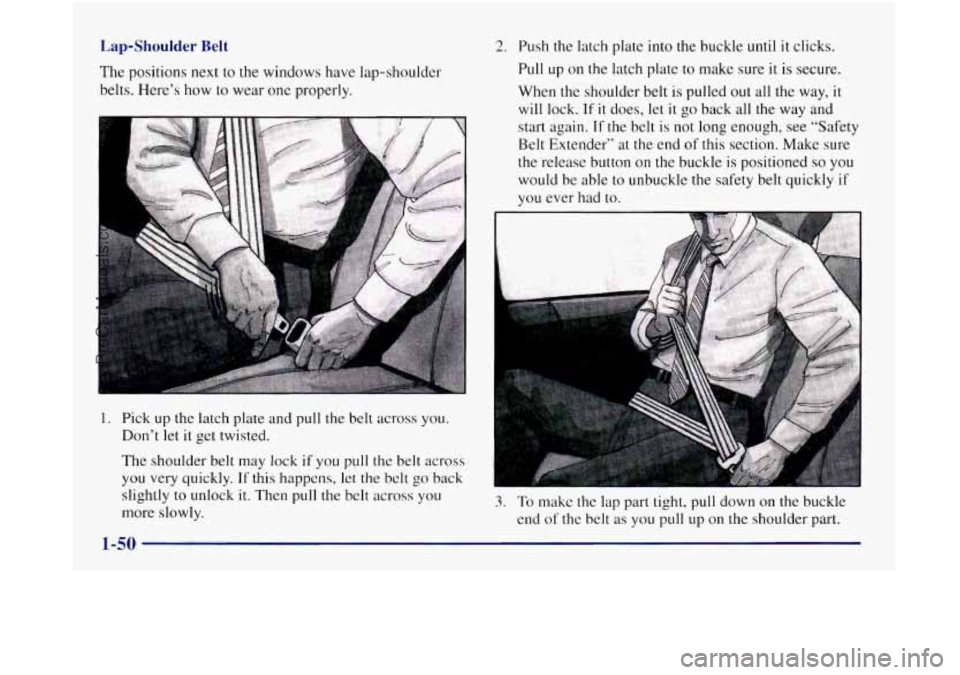
Lap-Shoulder Belt
The positions next to the windows have lap-shoulder
belts. Here’s how to wear one properly.
1. Pick up the latch plate and pull the belt across you.
Don’t let it get twisted.
The shoulder belt may lock
if you pull the belt across
you very quickly.
If this happens, let the belt go back
slightly to unlock
it. Then pull the belt across you
more slowly.
2. Push the latch plate into the buckle until it clicks.
Pull
up on the latch plate to make sure it is secure.
When the shoulder belt
is pulled out all the way, it
will lock. If it does, let it go back all the way and
start again.
If the belt is not long enough, see “Safety
Belt Extender” at
the end of this section. Make sure
the release button
on the buckle is positioned so you
would be able to unbuckle the safety belt quickly if
you ever had to.
3. To make the lap part tight, pull down on the buckle
end of the belt as you pull up on the shoulder part.
1-50
ProCarManuals.com
Page 85 of 436

Larger Children
Children who have outgrown child restraints should
wear the vehicle’s safety belts. If
you have the choice, a child should sit next to a
window
so the child can wear a lap-shoulder belt and
get the additional restraint a shoulder belt can provide.
Accident statistics show that children are safer if they
are restrained in the rear seat. But they need to use the
safety belts properly.
0 Children who aren’t buckled up can be thrown out in
a crash.
0 Children who aren’t buckled up can strike other
people who are.
1-77
ProCarManuals.com
Page 89 of 436
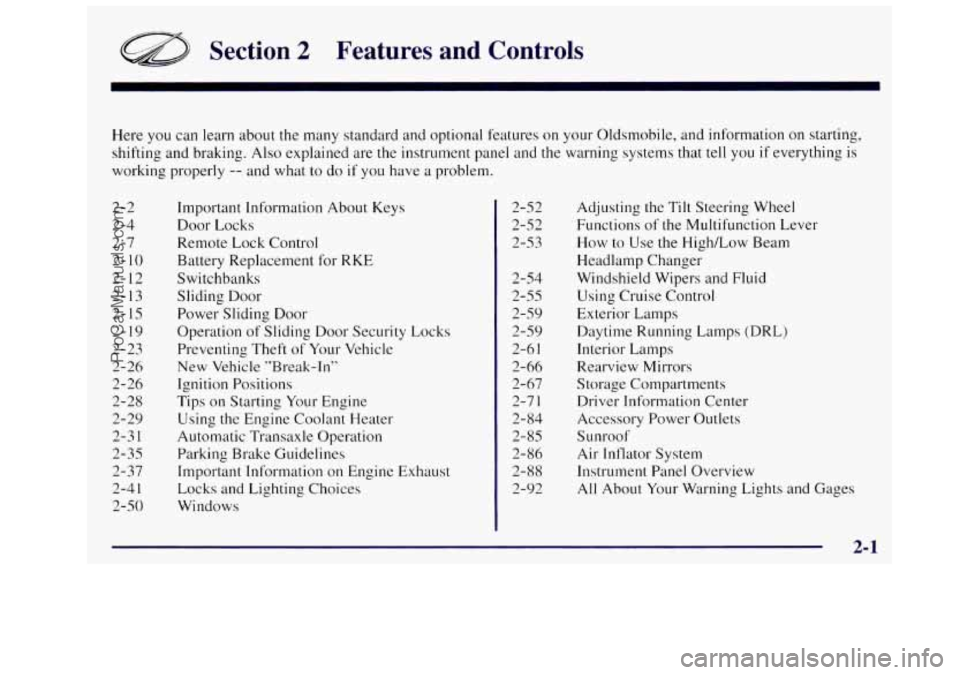
Section 2 Features and Controls
Here you can learn about the many standard and optional features on your Oldsmobile, and information on starting,
shifting and braking. Also explained are the instrument panel and the warning systems that
tell you if everything is
working properly
-- and what to do if you have a problem.
2-2 2-4
2-7
2-
10
2- 12
2-13 2-15
2-19
2-23
2-26 2-26
2-28 2-29
2-3 1
2-35
2-37
2-4
1
2-50 Important Information About Keys
Door Locks
Remote Lock
Control
Battery Replacement for RKE
Switchbanks
Sliding Door
Power Sliding Door
Operation of Sliding Door Security Locks
Preventing Theft
of Your Vehicle
New Vehicle "Break-In"
Ignition Positions
Tips on Starting
Your Engine
Using the Engine Coolant Heater
Automatic Transaxle Operation
Parking Brake Guidelines
Important Information on Engine Exhaust
Locks and Lighting Choices
Windows 2-52
2-52
2-53
2-54
2-55
2-59
2-59
2-6
I
2-66
2- 67
2-7
I
2- 84
2-85
2- 86
2-88
2-92 Adjusting the
Tilt Steering
Wheel
Functions of the Multifunction Lever
How to Use
the High/Low Beam
Headlamp Changer
Windshield Wipers and Fluid
Using Cruise Control
Exterior Lamps
Daytime Running Lamps (DRL)
Interior Lamps
Rearview Mirrors
Storage Compartments
Driver Information Center
Accessory Power Outlets
S u nroo f
Air Inflator System
Instrument Panel Overview
All About Your Warning Lights and Gages
ProCarManuals.com
Page 90 of 436

Keys
I
Leaving young children in a vehicle with the
ignition key is dangerous
for many reasons.
A child or others could be badly injured or
even killed.
They could operate power windows or other
controls or even make the vehicle move. Don't
leave the keys
in a vehicle with young children.
2-2
ProCarManuals.com
Page 100 of 436
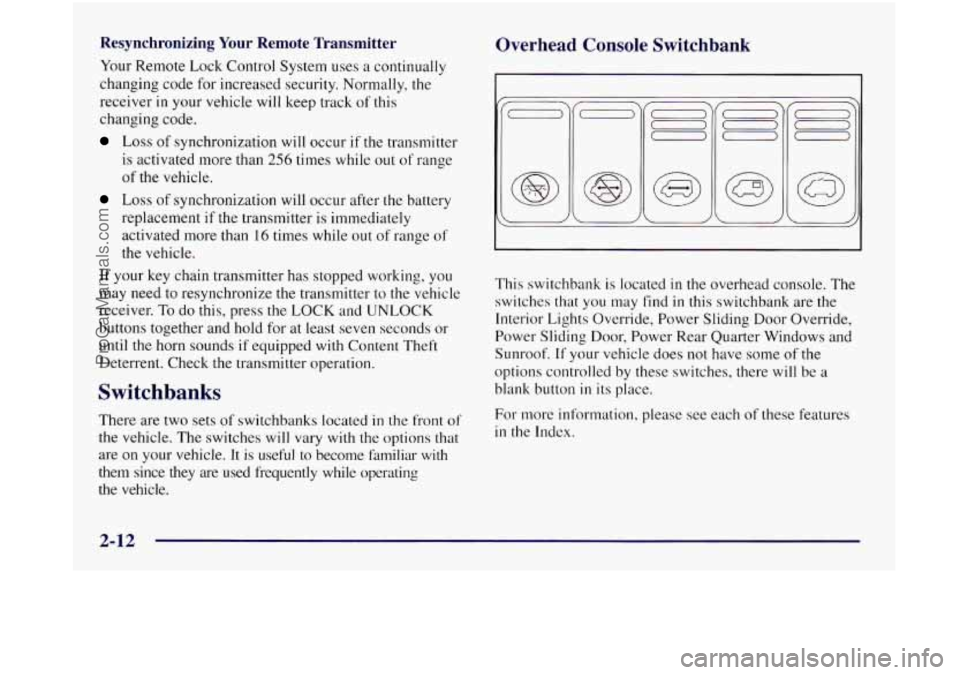
Resynchronizing Your Remote Transmitter
Your Remote Lock Control System uses a continually
changing code for increased security. Normally, the
receiver
in your vehicle will keep track of this
changing code.
Loss of synchronization will occur if the transmitter
is activated more than
256 times while out of range
of the vehicle.
Loss of synchronization will occur after the battery
replacement if the transmitter is immediately
activated more than
16 times while out of range of
the vehicle.
If your key chain transmitter has stopped working, you
may need to resynchronize the transmitter to the vehicle
receiver. To do this, press the
LOCK and UNLOCK
buttons together and hold for at least seven seconds or
until the horn sounds if equipped with Content Theft
Deterrent. Check the transmitter operation.
Switchbanks
There are two sets of switchbanks located in the front of
the vehicle, The switches will vary with the options that
are on your vehicle. It
is useful to become familiar with
them since they are used frequently while operating
the vehicle.
Overhead Console Switchbank
This switchbank is located in the overhead console. The
switches that you may find
in this switchbank are the
Interior Lights Override, Power Sliding Door Override,
Power Sliding
Door, Power Rear Quarter Windows and
Sunroof.
If your vehicle does not have some of the
options controlled by these switches, there
will be a
blank button
in its place.
For more information, please see each of these features
in the Index.
2-12
ProCarManuals.com
Page 101 of 436

Instrument Panel Switchbank
This switchbank is located in the instrument panel below
the Comfort Controls. The switches and controls that
you may find
in this switchbank are the Rear Fan Knob,
Rear Window WiperNasher, Fog Lamps and Traction
Control.
If your vehicle does not have some of the
options controlled by these switches, there will
be a
blank button
in its place.
For more information, please see each
of these features
in the Index.
If your vehicle is not equipped with the Optional Rear
Climate Control system, there
will be a storage space in
this switchbank. The rubber mat can be removed for
cleaning. Snap the mat into place after cleaning.
Sliding Door
To open the sliding door from outside the vehicle, pull
the handle out and then pull the door toward
the rear. If
you slide the door all the way back, the door will rest in
a detent position. The door must overcome this detent
when closing.
To move the door forward, you must first pull the door
past
the open detent position.
Does your Oldsmobile have a sliding door on the left
side? If
it does, this door is designed to open only a little
if the fuel door is open. If this ever happens, don’t try to
force
the sliding door. Just close the left-side sliding
door. Then when the fuel filler door is closed, the
left-side sliding door can be opened normally.
2-13
ProCarManuals.com
Page 110 of 436
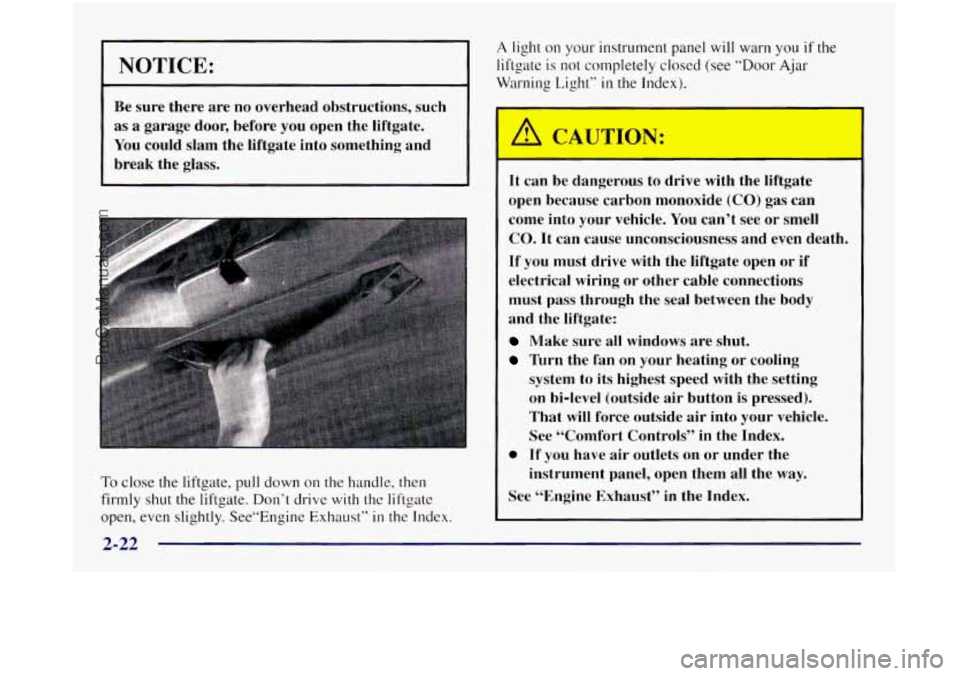
~ NOTICE:
Be
sure there are no overhead obstructions, such
as a garage door, before you open the liftgate.
You could slam the liftgate into something and
break the glass.
To close the liftgate, pull down on the handle, then
firmly shut
the liftgate. Don’t drive with the liftgate
open, even slightly. See“Engine Exhaust” in the Index.
A light on your instrument panel will warn you if the
liftgate is not completely closed (see “Door Ajar
Warning Light” in the Index).
It can be dangerous to drive with the liftgate
open because carbon monoxide (CO) gas can
come into your vehicle. You can’t see or smell
CO. It can cause unconsciousness and even death.
If you must drive with the liftgate open or if
electrical wiring or other cable connections
must pass through the seal between the body
and the liftgate:
Make sure all windows are shut.
Turn the fan on your heating or cooling
system to its highest speed with the setting
on bi-level (outside air button
is pressed).
That
will force outside air into your vehicle.
See “Comfort Controls”
in the Index.
0 If you have air outlets on or under the
instrument panel, open them all the way.
See “Engine Exhaust” in the Index.
2-22
ProCarManuals.com
Page 111 of 436

Content Theft-Deterrent (Option)
If your vehicle has this option, it has a theft-deterrent
alarm system.
A light located on top of your instrument panel (near the
center
of the vehicle, next to the windshield) will flash
slowly to let everyone
know that the system has
been armed.
While armed, the doors will not unlock
with the power
lock switch. Once armed,
the alarm will
go off if someone tries to
enter the vehicle (without using the key chain
transmitter or a key), breaks a window, tries
to damage
the vehicle or turns the ignition on. The horn will sound
and your vehicle’s park lamps will flash for up to
two
minutes. The system will also cut off the fuel supply,
preventing the vehicle from being driven.
When the alarm is armed, the liftgate may be opened
with the key chain transmitter or with a key.
Arming with the Power Lock Switch
Your alarm system will arm when you use either power
lock switch to lock
the doors while any door or the
liftgate is open and the key is removed from the ignition
(if you would like to turn off power lock switch arming,
see “Locks and Lighting Choices”
in the Index).
The security light flashes quickly to let you know when
the system
is ready to arm with the power door lock
switches. The security light will stop flashing and stay
011, when you press the rear of the power lock switch, to
let you know the system is arming. After all doors and
the liftgate are closed and locked, the security light will
begin flashing
at a very slow rate to let you know the
system is armed.
2-23
ProCarManuals.com